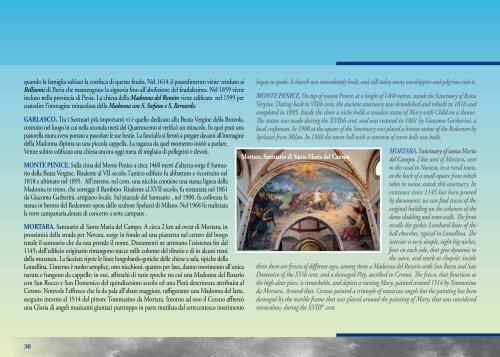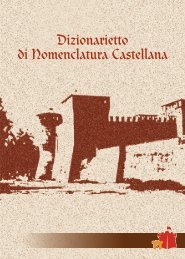luoghi e percorsi tra arte e fede nelle - Provincia di Cremona
luoghi e percorsi tra arte e fede nelle - Provincia di Cremona
luoghi e percorsi tra arte e fede nelle - Provincia di Cremona
Create successful ePaper yourself
Turn your PDF publications into a flip-book with our unique Google optimized e-Paper software.
quando la famiglia subisce la confisca <strong>di</strong> questo feudo. Nel 1614 il posse<strong>di</strong>mento viene venduto ai<br />
Bellisomi <strong>di</strong> Pavia che mantengono la signoria fino all’abolizione del feudalesimo. Nel 1859 viene<br />
incluso nella provincia <strong>di</strong> Pavia. La chiesa della Madonna del Romito viene e<strong>di</strong>ficata nel 1599 per<br />
custo<strong>di</strong>re l’immagine miracolosa della Madonna con S. Stefano e S. Bernardo.<br />
Garlasco. Tra i Santuari più importanti vi è quello de<strong>di</strong>cato alla Beata Vergine della Bozzola,<br />
costruito nel luogo in cui nella seconda metà del Quattrocento si verificò un miracolo. In quei prati una<br />
pastorella muta aveva portato a pascolare le sue bestie. La fanciulla si fermò a pregare davanti all’immagine<br />
della Madonna <strong>di</strong>pinta su una piccola cappella. La ragazza da quel momento iniziò a parlare.<br />
Venne subito e<strong>di</strong>ficata una chiesa ancora oggi meta <strong>di</strong> migliaia <strong>di</strong> pellegrini e devoti.<br />
Monte Penice. Sulla cima del Monte Penice a circa 1460 metri d’altezza sorge il Santuario<br />
della Beata Vergine. Risalente al VII secolo, l’antico e<strong>di</strong>ficio fu abbattuto e ricostruito nel<br />
1818 e ultimato nel 1895. All’interno, nel coro, una nicchia contiene una statua lignea della<br />
Madonna in trono, che sorregge il Bambino. Risalente al XVII secolo, fu restaurata nel 1861<br />
da Giacomo Garbarini, artigiano locale. Sul piazzale del Santuario , nel 1900, fu collocata la<br />
statua in bronzo del Redentore opera dello scultore Speluzzi <strong>di</strong> Milano. Nel 1968 fu realizzata<br />
la torre campanaria,dotata <strong>di</strong> concerto a sette campane .<br />
Mortara. Santuario <strong>di</strong> Santa Maria del Campo. A circa 2 km ad ovest <strong>di</strong> Mortara, in<br />
prossimità della s<strong>tra</strong>da per Novara, sorge in fondo ad una piazzetta nel centro del borgo<br />
rurale il santuario che da essa prende il nome. Documenti ne attestano l’esistenza fin dal<br />
1145; dell’e<strong>di</strong>ficio originario rimangono <strong>tra</strong>cce <strong>nelle</strong> colonne del tiburio e <strong>di</strong> in alcuni <strong>tra</strong>tti<br />
della muratura. La facciata ripete le linee longobardo-gotiche delle chiese a sala, tipiche della<br />
Lomellina. L’interno è molto semplice, otto nicchioni, quattro per lato, danno movimento all’unica<br />
navata e fungono da cappelle: in essi, affreschi <strong>di</strong> varie epoche <strong>tra</strong> cui una Madonna del Rosario<br />
con San Rocco e San Domenico del quin<strong>di</strong>cesimo secolo ed una Pietà deteriorata attribuita al<br />
Cerano. Notevole l’affresco che fa da pala all’altare maggiore, raffigurante una Madonna del latte,<br />
eseguito intorno al 1514 dal pittore Tommasino da Mortara. Intorno ad esso il Cerano affrescò<br />
una Gloria <strong>di</strong> angeli musicanti giuntaci purtroppo in p<strong>arte</strong> mutilata dal settecentesco inserimento<br />
began to speak. A church was imme<strong>di</strong>ately built, and still today many worshippers and pilgrims visit it.<br />
Monte PeniCe. On top of mount Penice, at a height of 1460 metres, stands the Sanctuary of Beata<br />
Vergine. Dating back to VIIth cent, the ancient sanctuary was demolished and rebuilt in 1818 and<br />
completed in 1895. Inside the choir a niche holds a wooden statue of Mary with Child on a throne.<br />
The statue was made during the XVIIth cent, and was restored in 1861 by Giacomo Garbarini, a<br />
local craftsman. In 1900 at the square of the Sanctuary was placed a bronze statue of the Redeemer by<br />
Speluzzi from Milan. In 1968 the tower bell with a concerto of seven bells was built.<br />
Mortara. sanctuary of santa Maria<br />
del Campo. 2 km west of Mortara, next<br />
to the road to Novara, in a rural town,<br />
at the back of a small square from which<br />
takes its name, stands this sanctuary. Its<br />
existence since 1145 has been proved<br />
by documents; we can find <strong>tra</strong>ces of the<br />
original buil<strong>di</strong>ng on the columns of the<br />
dome clad<strong>di</strong>ng and some walls. The front<br />
recalls the gothic Lombard lines of the<br />
hall churches, typical in Lomellina. The<br />
interior is very simple, eight big niches,<br />
four on each side, that give dynamic to<br />
the nave, and work as chapels: inside<br />
them there are frescos of <strong>di</strong>fferent ages, among them a Madonna del Rosario with San Rocco and San<br />
Domenico of the XVth cent, and a damaged Pity, ascribed to Cerano. The fresco, that functions as<br />
the high altar piece, is remarkable, and depicts a nursing Mary, painted around 1514 by Tommasino<br />
da Mortara. Around that, Cerano painted a triumph of musician angels but the painting has been<br />
damaged by the marble frame that was placed around the painting of Mary, that was considered<br />
miraculous, during the XVIIIth Mortara. santuario <strong>di</strong> santa Maria del campo<br />
cent.<br />
I SANTUARI MARIANI<br />
Marian Shrines<br />
<strong>di</strong> una cornice in marmo a far da contorno all’immagine della Madonna, considerata miracolosa.<br />
Palestro. Santuario della Madonna della Neve. Le sue origini risalgono alla cappella <strong>di</strong> S.<br />
Orso <strong>di</strong>pendente da Vinzaglio e quin<strong>di</strong> dalla Pieve <strong>di</strong> Confienza. La cappella <strong>di</strong> S. Orso è citata in<br />
documenti del 1229 poi in una carta ven<strong>di</strong>tionis del 1262. Nell’anno 1437 i confini <strong>tra</strong> il Ducato <strong>di</strong><br />
Milano (Palestro) e il Ducato <strong>di</strong> Savoia (Vercelli-Vinzaglio) furono segnati corrispondenti alla s<strong>tra</strong>da<br />
campestre che scorre accanto alla chiesetta, che ancor oggi <strong>di</strong>vide, in quella zona, il Piemonte dalla<br />
Lombar<strong>di</strong>a. In data non nota della fine del 1400 la cappella passò, quin<strong>di</strong>, sotto le cure dei palestresi<br />
o del Palestrese che l’aveva acquistata con il terreno. Essa era scomparsa solo sui documenti ufficiali.<br />
Un’al<strong>tra</strong> notizia è dell’anno 1772. In una relazione dello “stato della Parrocchia <strong>di</strong> S. Martino <strong>di</strong><br />
Palestro”, redatta dal Rettore Don G.F. Turchelli e depositata presso<br />
l’Archivio della Curia <strong>di</strong> Vercelli è citata la chiesa della “Madonnina<br />
della Neve” posta sulla s<strong>tra</strong>da <strong>di</strong> Vinzaglio. Quin<strong>di</strong> <strong>tra</strong> il 1675 e il 1772<br />
avvenne il cambio <strong>di</strong> denominazione e in più la costruzione dell’abside<br />
a semicerchio e della sacrestia.<br />
san Martino siccoMario. All’uscita dal paese si incon<strong>tra</strong> il<br />
Santuario della Madonna delle Grazie. All’interno l’abside è decorata<br />
dall’affresco cinquecentesco dell’Addolorata.<br />
sannazzaro de’ BurGon<strong>di</strong>. Santuario della Madonna della<br />
Fontana sorge in un luogo in cui, racconta la leggenda, la Madonna fece<br />
sgorgare miracolosamente acqua dalla roccia. E’ nota anche come Chiesa<br />
delle Assi perché durante le piene del Po l’immagine della Vergine veniva<br />
protetta con assi. A poca <strong>di</strong>stanza si trova l’arco costruito in ricordo della<br />
devastante inondazione del Po del 1704 .<br />
<strong>tra</strong>vacò siccoMario. A pochi chilometri da Pavia, con una piccola<br />
deviazione dal percorso della Via Francigena, si giunge al Santuario <strong>di</strong><br />
Santa Maria de Travacato del 1225. Costruito su una preesistente abbazia,<br />
l’esterno restaurato mantiene la struttura originaria a capanna.<br />
sannazzaro de’ Burgon<strong>di</strong>.<br />
santuario della Madonna<br />
della Fontana<br />
PaLestro. sanctuary of Madonna della neve. Its origins date back to the chapel of S. Orso, subor<strong>di</strong>nated<br />
to Vinzaglio and thus to Pieve <strong>di</strong> Confienza. The Chapel of S. Orso is mentioned in documents<br />
of 1229 and in a carta ven<strong>di</strong>tionis of 1262. In 1437 the borders of the dukedom of Milan (Palestro)<br />
and the dukedom of Savoia (Vercelli-Vinzaglio) were marked along the country road that runs next to<br />
the small church, and that today still <strong>di</strong>vides Piemonte and Lombar<strong>di</strong>a. At the end of 1400 the chapel<br />
was placed under the care of a local that bought the land, and vanished from official documents. We<br />
have an update in 1772, the church of Madonnina della Neve on the road of Vinzaglio is mentioned<br />
in a report about “the state of the parish of S. Martino <strong>di</strong> Palestro”, wrote by provost Don G.F. Turchelli<br />
and kept in the archive of Curia of Vercelli. Then between 1675 and 1772 it changed name and the<br />
semicircle apse and the sacristy were built.<br />
san Martino siCCoMario Leaving the<br />
town we meet the Sanctuary of Madonna delle<br />
Grazie. Inside, the apse is decorated by the XVIth<br />
cent fresco of Our Lady of Sorrows.<br />
sannazzaro De’ BurGonDi. The Sanctuary<br />
of Madonna della Fontana stands where,<br />
accor<strong>di</strong>ng to legends, Mary made water spring<br />
among rocks. This is also known as “Church<br />
of planks” because during floods the statue was<br />
protected with planks. At a close range stands the<br />
arch built in memory of the devastating flood that<br />
took place in 1704.<br />
<strong>tra</strong>vaCò siCCoMario. A few kilometres from<br />
Pavia, with a small deviation from the Via Fancigena,<br />
we come to the Sanctuary of Santa Maria de Travacato<br />
of 1225. Built on a pre-existing abbey, the outside<br />
has been restored keeping its original structure.<br />
30 31



